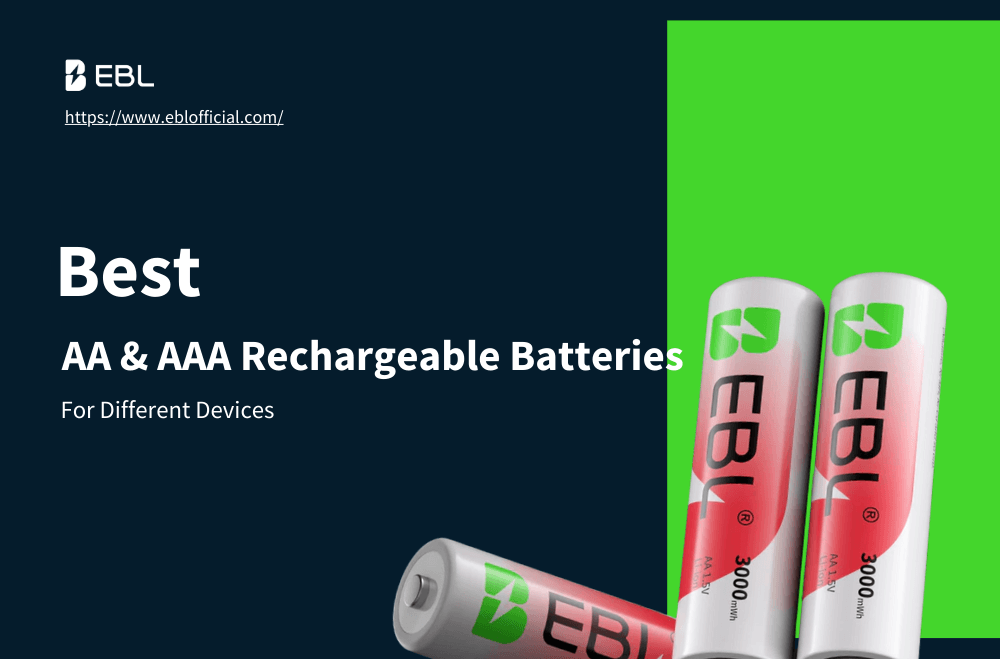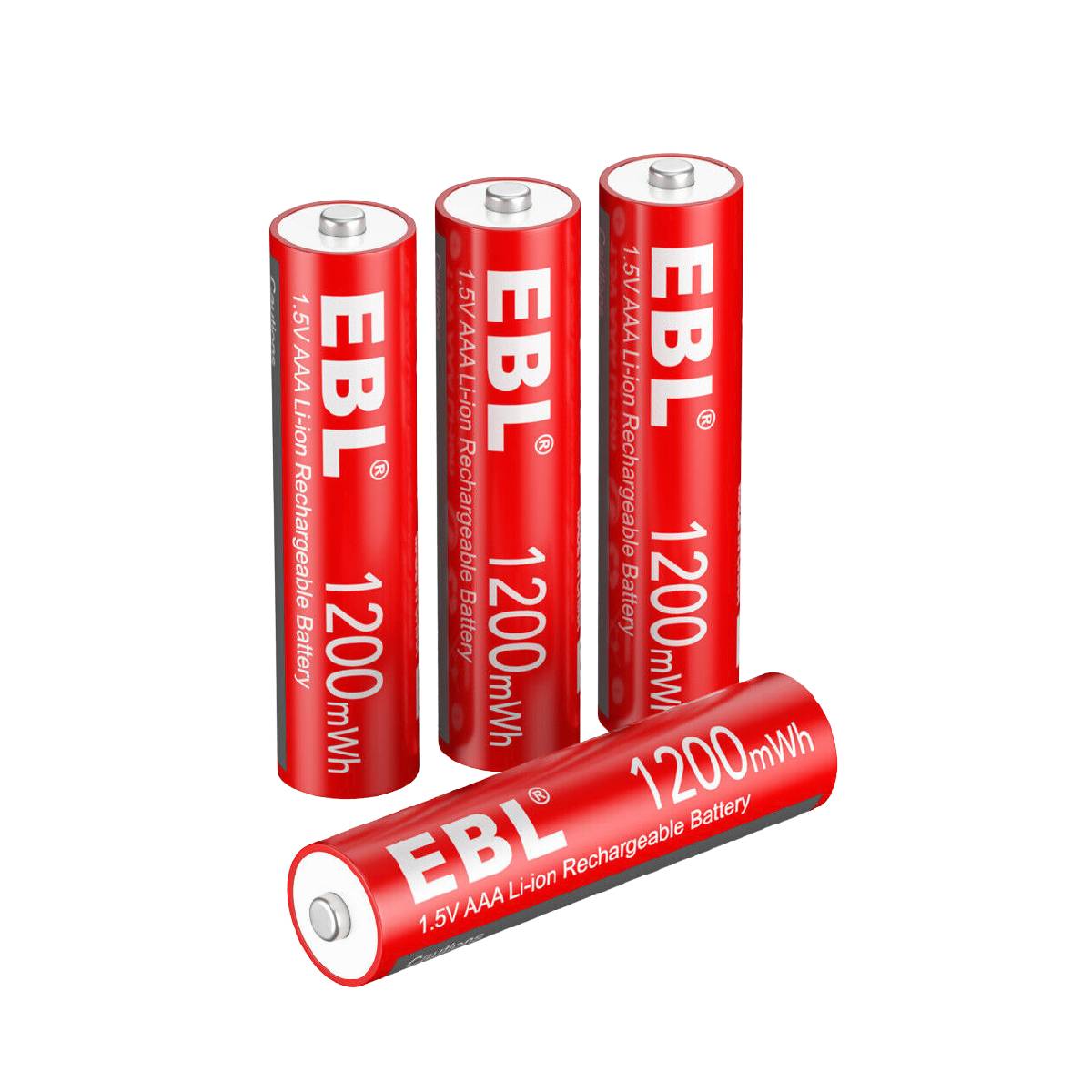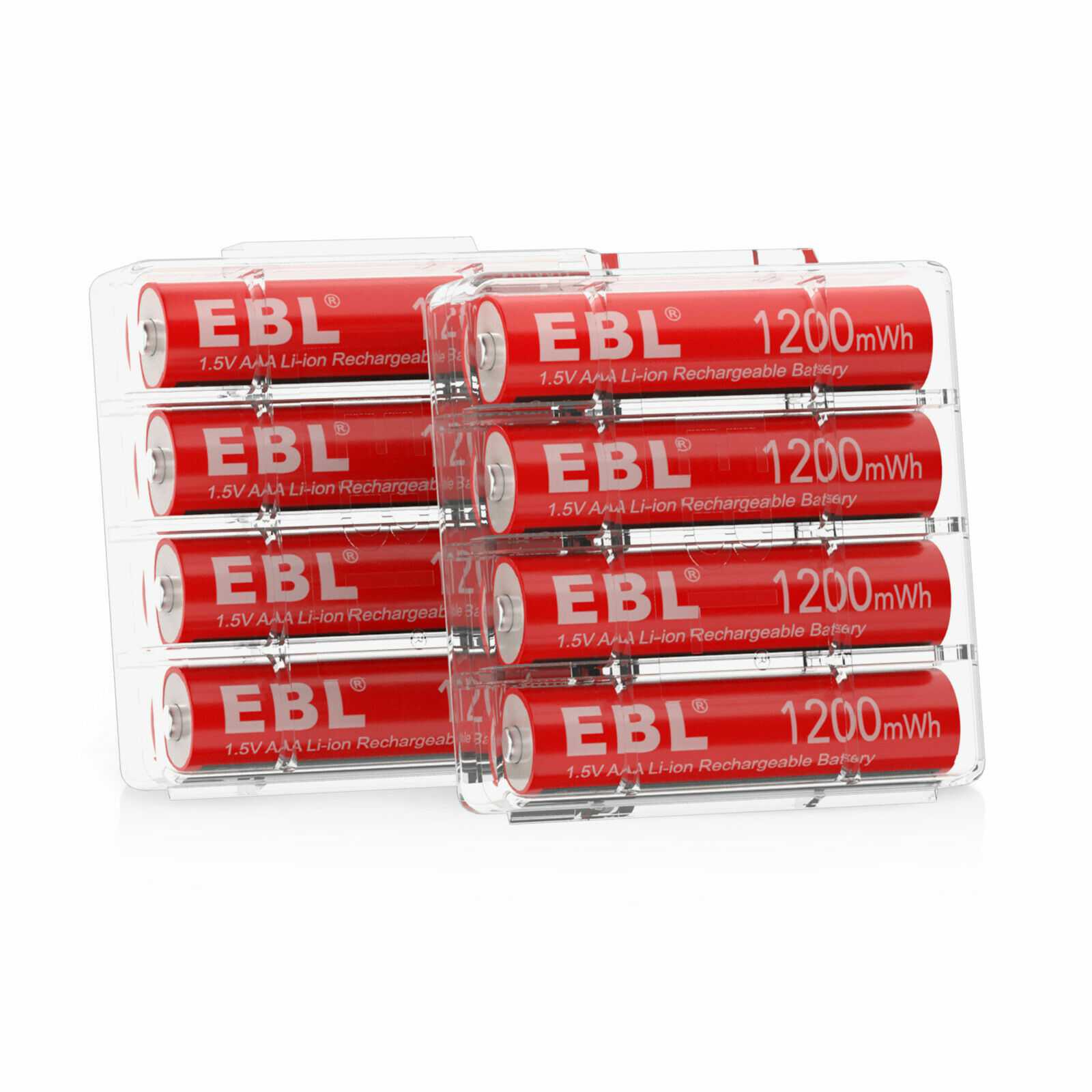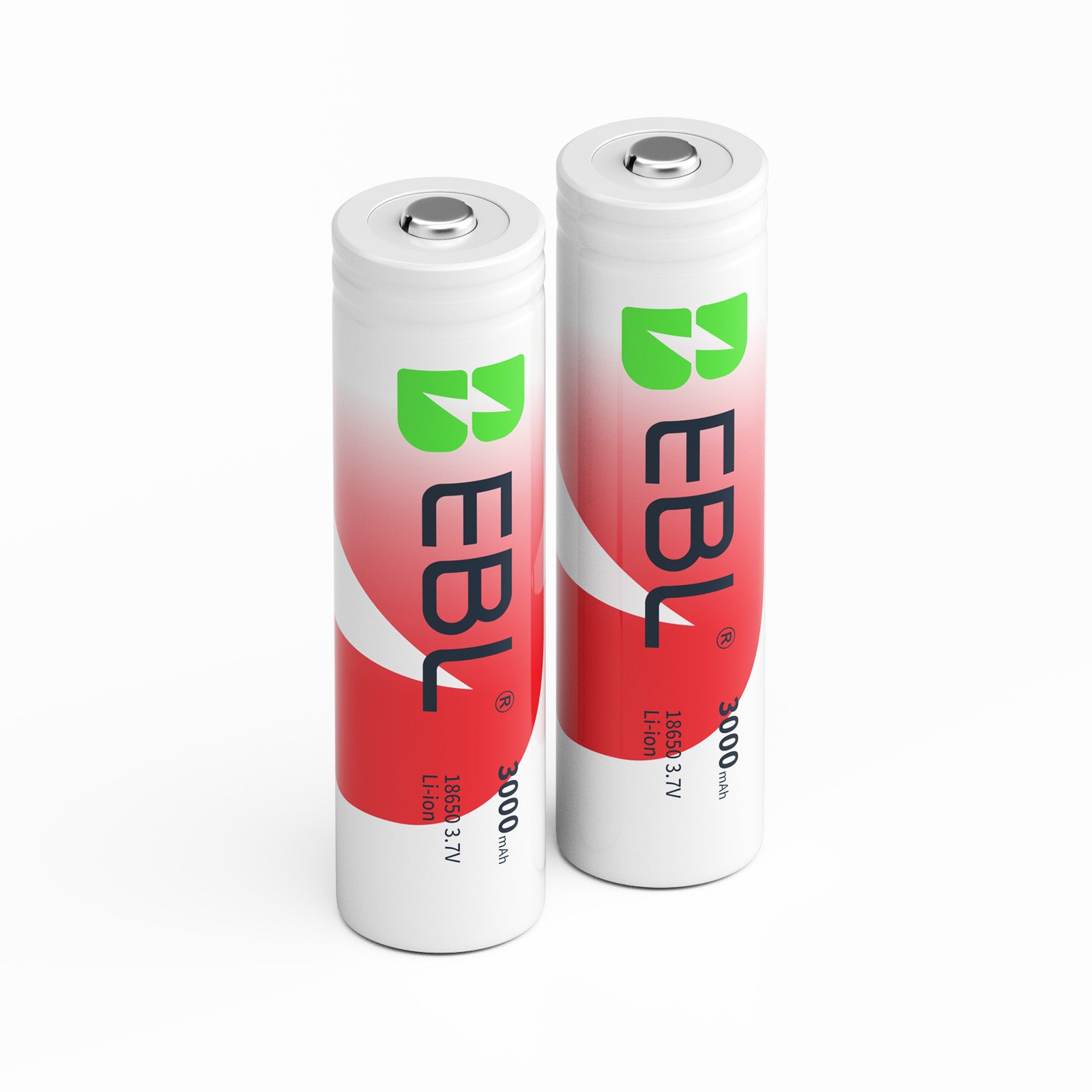Muchas baterías recargables estándar son solo de 1,2 V, lo cual no es suficiente para los dispositivos tecnológicos que consumen mucha energía.
Esta guía te mostrará por qué las mejores baterías recargables de litio AA funcionan con una tensión estable de 1,5 V y cómo pueden finalmente alimentar tus dispositivos de la forma prevista.
Tabla de contenido
- ¿Por qué se agotan tan rápido mis baterías NiMH de 1,2 V en algunos dispositivos?
- ¿Qué son las baterías recargables de litio AA de 1,5 V (y en qué se diferencian)?
- ¡Deja de comparar mAh!
- ¿Son seguras las baterías de litio de 1,5 V para mis dispositivos de 1,2 V?
- Las mejores baterías recargables de litio AA: ¿Qué tener en cuenta?
- Las mejores baterías recargables de litio para 2025, según EBL.
- Por qué es hora de actualizar tu sistema eléctrico
- Preguntas frecuentes
¿Por qué mis baterías NiMH de 1,2 V (como las Eneloop) se agotan tan rápido en algunos dispositivos?
Esos dispositivos de alto consumo, como el flash de tu cámara digital, los mandos de realidad virtual y la cerradura inteligente de tu puerta, consumen muchísima energía. No solo la consumen a cuentagotas; la devoran.
Estos dispositivos necesitan un voltaje específico y elevado para funcionar correctamente. Cuando el voltaje es demasiado bajo, simplemente dejan de funcionar.
Comprender el estándar alcalino de 1,5 V (para qué se diseñó su equipo)
Lo que sucede es que el fabricante de su dispositivo da por sentado que está utilizando una batería alcalina desechable de 1,5 V.
Casi todos los dispositivos electrónicos de consumo que funcionan con pilas AA están diseñados para funcionar con una tensión inicial de 1,5 voltios. Es el estándar mundial.
Cómo una caída de tensión de 1,2 V en una batería NiMH activa prematuramente las advertencias de "batería baja"
Ahora bien, hablemos de las baterías NiMH de 1,2 V. Son ideales para cosas como mandos a distancia de televisores y relojes, pero parten de una desventaja de 1,2 V.
Para tus equipos de alto consumo, esos 1,2 V son apenas suficientes.
Pero aquí está el verdadero problema: la caída de tensión. En cuanto empiezas a usar una batería NiMH, su tensión comienza a disminuir. Una vez que alcanza 1,1 V o 1,0 V, el sensor de batería baja de tu dispositivo se activa y se apaga.
La batería no está descargada. Puede que aún tenga un 60 % de carga. Pero ya no puede suministrar el voltaje que tu dispositivo necesita. Es como intentar arrancar un camión con la batería de una motocicleta.
Este fallo constante resulta frustrante. ¿Pero qué pasaría si una batería combinara la reutilización de las NiMH con la potencia de 1,5 V de una alcalina? Ahí es precisamente donde entran en juego las mejores baterías recargables de litio AA.
¿Qué son las baterías recargables de litio AA de 1,5 V (y en qué se diferencian)?
Estas baterías son híbridas: concentran la potencia del litio en el práctico formato AA reutilizable.
Analicemos qué las hace fundamentalmente diferentes de cualquier otra batería que hayas usado.
La promesa de potencia de 1,5 V, del 100 % al 0 %
¿Recuerdan el problema de la caída de tensión con las baterías NiMH? Las baterías recargables de litio AA de 1,5 V lo solucionan por completo.
No empiezan en 1,5 V y luego bajan. Empiezan en 1,5 V y se mantienen constantes a 1,5 V hasta que la batería se agota. Para tu dispositivo de alto consumo, esto supone una revolución. Recibe una potencia completa y constante durante todo el ciclo de carga. Se acabaron los apagones prematuros.
Diferencia entre baterías recargables de iones de litio y baterías desechables de litio
Este es un punto de confusión común. Es posible que hayas visto pilas AA de "litio" en las tiendas, pero eran desechables.
Son baterías de litio metálico (como Li-FeS2). Son estupendas, pero se usan una sola vez y se desechan.
Las baterías recargables AA de litio son de iones de litio (Li-ion). Utilizan una química diferente, similar a la de tu teléfono inteligente, que les permite recargarse una y otra vez, a menudo más de 1000 veces.
Explicación de los circuitos de protección integrados de EBL
No se puede simplemente dotar a una pila AA de la potencia de un smartphone sin gestionarla. Dentro de cada pila de iones de litio EBL de 1,5 V hay un pequeño «cerebro»: un circuito de protección integrado.
Hemos diseñado este chip para gestionar la energía de forma segura. Evita la sobrecarga, impide la sobredescarga (que puede dañar la batería) y protege contra cortocircuitos. Es el que proporciona esos 1,5 V constantes y garantiza la seguridad de tus baterías y dispositivos.
Seguramente te has fijado en la capacidad (mAh) de estas baterías y has pensado que era menor que la de tus NiMH. Eso se debe a que mAh no es la medida correcta. Hablemos de la métrica real para la duración de la batería.
¡Deja de comparar mAh!
Lo vemos todo el tiempo. Un cliente mira una batería NiMH de 2800 mAh junto a una de nuestras baterías de litio de 2200 mAh y piensa: "la NiMH es más potente".
Este es el mayor error que puedes cometer al comprar. Estamos aquí para desmentir este mito de una vez por todas.
¿Por qué una batería NiMH de 2500 mAh no equivale a una batería de litio de 2000 mAh?
Comparar baterías con diferentes voltajes utilizando miliamperios-hora (mAh) es como comparar el tamaño de dos motores de coche sin saber si uno es un V8 y el otro es eléctrico.
- mAh (miliamperios-hora): Esta unidad mide la capacidad de carga. Es como la cantidad de combustible en un tanque.
- mWh (milivatio-hora): Esta unidad de medida es la energía. Indica cuánto trabajo puede realizar realmente ese combustible.
Una batería NiMH de 2500 mAh solo tiene 1,2 V. Una batería de litio de 2200 mAh tiene 1,5 V. Esa diferencia de voltaje lo es todo.
Cómo calcular la energía real (mWh)
La fórmula para calcular la energía real de una batería es simple:
Voltaje (V) x Carga (mAh) = Energía (mWh)
Vamos a usar esto para calcular el rendimiento de esas dos baterías.
Litio de 1,5 V frente a NiMH de 1,2 V
Aquí termina el lenguaje de marketing y comienza la ciencia.
- Batería NiMH de 1,2 V: 1,2 voltios x 2800 mAh = 3360 mWh de energía
- Batería de litio de 1,5 V: 1,5 voltios x 2200 mAh = 3300 mWh de energía
De repente, parecen casi idénticas en poder, ¿verdad?
Las mejores baterías recargables de litio ofrecen mayor energía total. Además, la suministran a un voltaje estable de 1,5 V, para que tu dispositivo pueda aprovechar el 100 % de esa energía, no solo la que supera los 1,1 V.
¿Son seguras las baterías de litio de 1,5 V para mis dispositivos de 1,2 V?
Instalar una batería "más potente" en tus aparatos electrónicos resulta arriesgado.
En resumen: sí, en casi todos los casos, las baterías de litio de 1,5 V no solo son seguras, sino que además son mejores para tus dispositivos que las de NiMH. Veamos el sencillo motivo.
Respuesta corta: Sí. He aquí el porqué.
Tu dispositivo no está diseñado para 1,2 V. Está fabricado para pilas alcalinas desechables de 1,5 V. Una pila alcalina nueva puede tener un voltaje de 1,6 V o incluso 1,8 V, y tu dispositivo funciona perfectamente con este voltaje.
Los 1,2 V de una batería NiMH son, en realidad, el mínimo que tu dispositivo puede tolerar. Unos 1,5 V estables y constantes de una batería de iones de litio no son «demasiada potencia»; es la potencia exacta para la que se diseñó tu dispositivo.
El verdadero peligro no es el voltaje; es la carga y descarga incontroladas.
Cómo los circuitos de protección avanzados evitan la sobrecarga y los daños
Una pila de iones de litio "en bruto", como la que lleva tu teléfono, tiene en realidad una tensión nominal de 3,7 V. No puedes colocarla en una ranura AA.
Por eso, todas las pilas de litio AA EBL de 1,5 V incorporan un chip inteligente. Este chip realiza tres funciones esenciales:
- Es un "convertidor reductor" que disminuye de forma segura el voltaje de 3,7 V a 1,5 V perfectamente estables.
- Proporciona protección contra sobrecargas , cortando la corriente cuando la batería está llena.
- Dispone de protección contra sobredescarga , que apaga la batería antes de que el voltaje caiga lo suficiente como para causar daños permanentes.
Esta tecnología integrada significa que obtienes todos los beneficios de la energía de litio sin ninguno de los riesgos.
Las mejores baterías recargables de litio AA: ¿Qué tener en cuenta?
Estas son las características clave que exigimos en las mejores baterías recargables de litio AA.
Característica imprescindible n.º 1: Salida constante real de 1,5 V
Esta es la característica más importante. No solo buscamos una tensión nominal de 1,5 V; buscamos una salida constante de 1,5 V. Esto significa que la batería proporciona el mismo voltaje óptimo tanto al 90 % de carga como al 10 %. Esta es la única manera de garantizar que tus dispositivos de alto consumo, como mandos de videojuegos y cámaras, funcionen a pleno rendimiento hasta que la batería se agote por completo.
Característica imprescindible n.º 2: Alta vida útil
La principal ventaja de las baterías recargables es ahorrar dinero y reducir los residuos. Una batería barata que se estropea tras 100 recargas no es una buena inversión. Buscamos baterías diseñadas para durar. Una celda de iones de litio de alta calidad debería soportar al menos entre 1000 y 1200 ciclos de carga. Esta es la verdadera medida de la vida útil y el valor a largo plazo de una batería.
Característica imprescindible n.° 3: Una marca en la que puedes confiar
Este mercado está plagado de marcas desconocidas con afirmaciones exageradas y sin fundamento. La reputación de una marca se construye a lo largo de años de rendimiento y seguridad confiables. Somos una marca de confianza desde 1998 porque respaldamos nuestras especificaciones. Recomendamos elegir una marca reconocida por su control de calidad y atención al cliente.
Opciones de carga: USB-C integrado frente a cargadores inteligentes dedicados
La forma en que cargas tus baterías importa.
- USB-C integrado: La máxima comodidad. Puedes cargar estas baterías en cualquier lugar donde puedas cargar tu teléfono, lo que las hace perfectas para viajar.
- Cargadores inteligentes específicos: Estos cargadores están diseñados específicamente para celdas de iones de litio de 1,5 V. Suelen cargar más rápido e incluyen funciones inteligentes para monitorizar el estado de cada batería, lo que puede ayudar a maximizar su vida útil.
Las mejores baterías recargables de litio para 2025, según EBL.
Tras décadas de pruebas, sabemos qué funciona. Cuando necesitas las mejores baterías recargables de litio, necesitas energía fiable, duradera y práctica. Estas son las baterías en las que confía nuestro propio equipo.
1. La mejor opción para dispositivos de alto consumo: baterías de litio AA EBL de 1,5 V y 3000 mWh.
Esta es nuestra batería de referencia. Para dispositivos que consumen mucha energía, como cámaras digitales, micrófonos inalámbricos y controladores de realidad virtual, las baterías EBL AA de 3000 mWh son la mejor opción.
Proporcionan una tensión constante de 1,5 V, lo cual es fundamental para que estos componentes electrónicos funcionen de la mejor manera.
Las hemos diseñado con nuestra tecnología ProCyco 1200, lo que significa que se pueden recargar hasta 1200 veces, ahorrándote una enorme cantidad de dinero y residuos en comparación con los productos desechables.
2. Ideales para la comodidad y los viajes: Pilas AA recargables EBL USB-C
Para la máxima comodidad, estos son los que necesitas. Nos encantan para viajar porque no necesitas un cargador aparte, que suele ser voluminoso.
Puedes cargarlos directamente con cualquier cable USB-C, el mismo que usas para tu portátil o teléfono.
Aún ofrecen una potente salida constante de 1,5 V y una alta vida útil, lo que las hace perfectas para viajar ligero sin sacrificar potencia.
3. Ideal para dispositivos pequeños (AAA): Pilas de litio AAA EBL de 1,5 V y 1200 mWh
No olvides tus dispositivos más pequeños. Nuestras baterías de litio AAA están fabricadas con la misma tecnología de alta capacidad y voltaje constante.
Son ideales para linternas frontales de alto rendimiento, mandos a distancia sofisticados y otros dispositivos pequeños que agotan las baterías NiMH de 1,2 V demasiado rápido.
Por qué es hora de actualizar tu sistema eléctrico
Durante años, "recargable" implicaba aceptar un compromiso: se obtenía la reutilización, pero se renunciaba a la potencia de 1,5 V para la que se habían diseñado los dispositivos. Todos nos resignábamos a ese intercambio de 1,2 V.
Esos días han terminado.
Tus dispositivos electrónicos de alto consumo no tienen por qué averiarse prematuramente. Ya no tienes que preguntarte si tu batería "llena" lo está realmente. Las baterías recargables de litio AA son una verdadera mejora, no un simple cambio. Ofrecen la potencia constante de 1,5 V de una pila alcalina con la reutilización y la alta energía (mWh) de las avanzadas baterías de iones de litio.
Como equipo apasionado por la tecnología de potencia desde 1998, nuestra recomendación es simple: deja de permitir que las baterías de 1.2V sean un cuello de botella. Es hora de actualizar tus equipos con la potencia para la que fueron diseñados.
Preguntas frecuentes
¿Qué tipo de batería de litio durará más tiempo?
Una batería de litio metálico de 1,5 V no recargable tiene la mayor vida útil, generalmente de 10 a 15 años. En cuanto a las baterías recargables, un modelo de iones de litio (Li-ion) de 1,5 V de calidad ofrece la mejor durabilidad, con alta energía y una larga vida útil de más de 1000 ciclos de carga.
¿Cuál es la mejor alternativa a las pilas AA de litio?
La mejor y más popular alternativa es una batería de níquel-metal hidruro (NiMH) de alta calidad. Aunque funcionan a un voltaje menor de 1,2 V, las modernas baterías NiMH de baja autodescarga son excelentes para dispositivos de bajo consumo como mandos a distancia y relojes.
¿Es seguro almacenar baterías de litio en casa?
Sí, es perfectamente seguro almacenar baterías de litio en casa si se siguen unas sencillas recomendaciones. Recomendamos guardarlas en un lugar fresco y seco a temperatura ambiente (idealmente entre 15 °C y 25 °C), lejos de la luz solar directa y de fuentes de calor.













Dejar un comentario
Todos los comentarios se revisan antes de su publicación.
Este sitio está protegido por hCaptcha y se aplican la Política de privacidad de hCaptcha y los Términos del servicio.